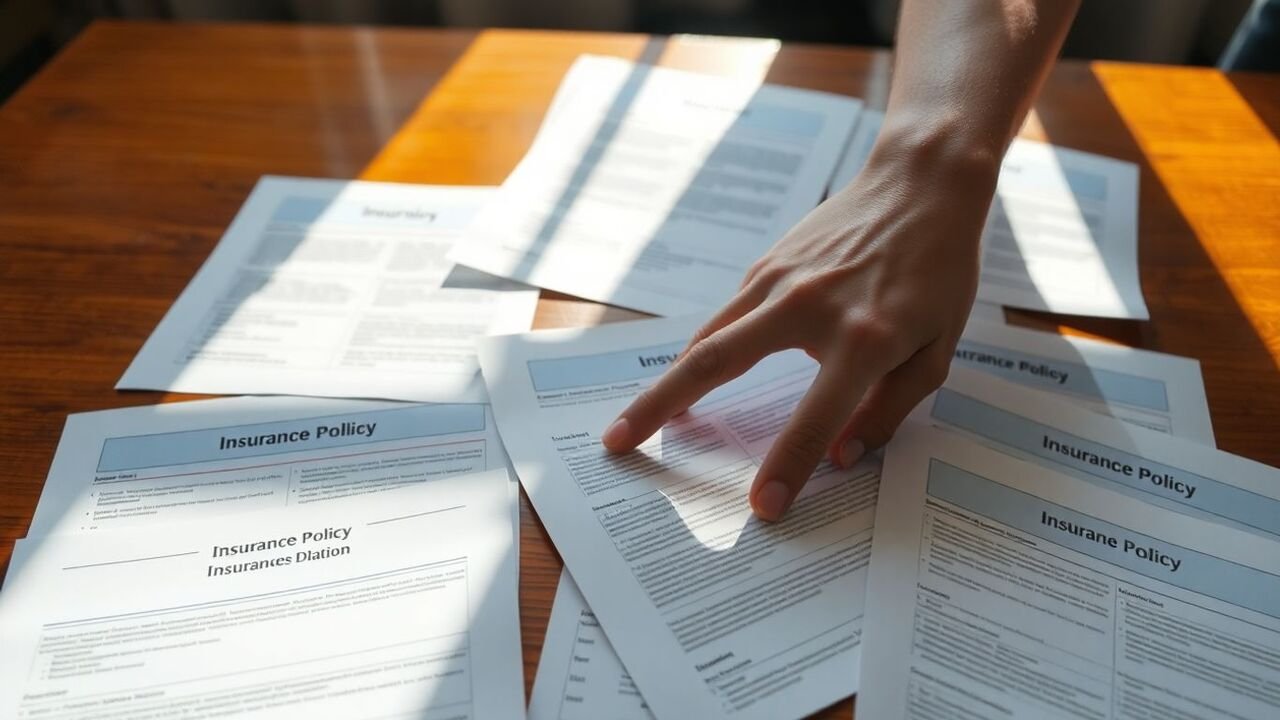Navigating Your Insurance Options: A Comprehensive Guide.
So, you need to figure out insurance. It can feel like a huge puzzle, right? Lots of terms, different types of plans, and trying to guess what might happen down the road. This guide is here to make it less confusing. We’ll walk through what you actually need, how to get it, and how to make sure you’ve got the right protection without overpaying. Think of it as your friendly, no-nonsense map to understanding insurance.
Thank you for reading this post, don't forget to subscribe!Key Takeaways
- Figure out what kind of protection you need by looking at your car’s value and how you drive. Know the difference between covering damage from accidents (collision) and damage from other things like theft or weather (comprehensive).
- Getting insurance involves talking to someone, filling out forms, and the company looking at your info to decide on the policy. Be ready to share details about your health and finances.
- Don’t just pick the first company you see. Check out reviews, see how they handle claims, and compare prices and what’s included in their policies.
- You can adjust your insurance by choosing how much you’ll pay if something happens (deductible) versus how much you pay regularly (premium). Make sure the policy fits your life.
- Insurance often comes with extra perks like roadside help or rental car coverage. Also, understand what your policy covers and what it doesn’t, like specific medical costs or wear and tear on your car.
Understanding Your Insurance Needs
So, you’re looking into insurance, huh? It can feel like a maze sometimes, trying to figure out what you actually need. It’s not just about getting some coverage; it’s about getting the right coverage for you. Think of it like packing for a trip – you wouldn’t bring a swimsuit to the Arctic, right? Same idea here. We need to figure out what your personal situation calls for.
Assessing Comprehensive vs. Collision Coverage
This is where a lot of people get tripped up. Let’s break it down simply. Collision coverage is pretty straightforward: it pays for damage to your car if you hit something, like another car, a tree, or a wall. It’s about the impact, the crash itself. Comprehensive coverage, on the other hand, is for everything else that might happen to your car that isn’t a collision. We’re talking about stuff like theft, vandalism, a tree branch falling on your car, or maybe it gets damaged in a flood or fire. It’s often called “other than collision” coverage for a reason.
Here’s a quick look at what each typically covers:
| Coverage Type | What it Covers |
|---|---|
| Collision | Damage from crashing into another vehicle or object (e.g., hitting a pole). |
| Comprehensive | Damage from non-collision events (e.g., theft, fire, hail, vandalism, falling trees). |
When you’re deciding, think about where you live and how you use your car. If you live in an area prone to severe weather or car theft, comprehensive might be more important. If you’re a city driver with lots of traffic, collision could be your main concern.
Determining What Insurance Should Include
Beyond just collision and comprehensive, what else should be in your insurance plan? It really depends on your life. For cars, liability coverage is usually a must-have, and often legally required. This covers damage or injuries you might cause to other people or their property if you’re at fault in an accident. Then there’s personal injury protection (PIP) or medical payments coverage, which can help with your own medical bills after an accident, regardless of who caused it. You might also want to think about uninsured or underinsured motorist coverage, just in case you run into someone who doesn’t have enough insurance to cover the damages.
- Liability (Bodily Injury & Property Damage)
- Collision
- Comprehensive
- Uninsured/Underinsured Motorist
- Medical Payments / PIP
Tailoring Coverage to Your Unique Requirements
This is the part where you really make the policy work for you. Your car’s age and value matter. If you have an older car that’s not worth much, paying for collision coverage might not make sense. You could end up paying more in premiums over time than the car is actually worth. On the flip side, if you have a brand-new car or a vehicle you owe a lot of money on, you’ll probably want to keep that collision and comprehensive coverage.
Your driving habits are also a big factor. Do you drive a lot? Mostly on highways? Or just short trips around town? These things can influence your risk and, therefore, what kind of coverage makes the most sense. It’s all about matching the policy to your lifestyle and financial comfort zone.
Think about your budget, too. Higher deductibles usually mean lower monthly payments, but you’ll pay more out-of-pocket if you have a claim. It’s a trade-off, and finding that balance is key to getting insurance that feels right.
Navigating the Insurance Acquisition Process
So, you’ve figured out what kind of insurance you need. Great! Now comes the part where you actually get the policy. It might seem a bit daunting, but it’s really just a series of steps designed to make sure you and the insurance company are on the same page. Think of it like getting a new phone plan – you talk to someone, fill out some paperwork, and then they set you up.
The Initial Consultation and Needs Analysis
This is where you sit down with an insurance agent or advisor. It’s not just about them selling you something; it’s about them understanding your life. They’ll ask about your job, your family, your assets, and your general lifestyle. This helps them figure out what kind of coverage makes sense for you. They’ll explain different options, like what comprehensive coverage actually covers versus collision, and why you might need one or both. It’s a good time to ask all your questions, no matter how basic they seem. Don’t be afraid to ask for clarification if something isn’t clear.
Completing Your Insurance Application
Once you’ve decided on a plan, you’ll need to fill out an application. This is where you provide more detailed information. Be honest and thorough here; it’s important for the next step. You’ll likely need to share:
- Personal details (name, address, date of birth)
- Information about what you’re insuring (like your car’s make, model, and VIN, or details about your home)
- Your driving record (if it’s auto insurance)
- Medical history (if it’s life or health insurance)
- Financial information (sometimes, depending on the policy)
This information helps the insurance company assess the risk they’d be taking on.
Understanding the Underwriting Process
This is the insurance company’s way of looking at your application and deciding if they can offer you a policy, and at what price. It’s basically a risk assessment. They might:
- Review your application details carefully.
- Check your driving record or claims history.
- For life or health insurance, they might require a medical exam or ask for a statement from your doctor.
- They might also do a credit check or an inspection report, depending on the type of insurance.
The underwriting process is key because it directly influences the terms and cost of your policy. Providing accurate information upfront can make this stage smoother and prevent issues down the line.
After underwriting, they’ll either approve your application, offer a policy with specific terms, or, in some cases, decline coverage. If approved, they’ll send you the official policy documents to review and sign.
Researching and Selecting Insurance Providers
So, you’ve figured out what kind of coverage you actually need. That’s a big step! Now comes the part where you have to pick who’s going to provide that coverage. It’s not just about finding the cheapest option, though that’s tempting. You really want to find a company that’s solid, reliable, and treats its customers well, especially when you actually need to file a claim. Think of it like choosing a contractor for a big home repair – you want someone you can trust to do the job right.
When you’re looking around, here are a few things to keep in mind:
- Company Reputation: What do other people say about them? Look for reviews online, maybe check with the Better Business Bureau, or even ask friends and family if they have experience with a particular insurer. A company with a good track record for customer service and paying claims fairly is worth its weight in gold.
- Policy Details: Don’t just look at the monthly price. Really dig into what the policy actually covers. Are there any weird exclusions? What’s the deductible like? Does it cover the specific things you’re worried about, like, say, hail damage if you live in a place where that happens a lot?
- Customer Service: How easy is it to get in touch with them? Are they helpful when you call with questions? This stuff matters, especially when you’re dealing with something as important as insurance.
It can feel like a lot of homework, but taking the time to compare different companies and their policies can save you a lot of headaches down the road. You’re looking for that sweet spot between good coverage, fair pricing, and a company that’s got your back when you need it most.
Customizing Your Insurance Policy

So, you’ve figured out what kind of coverage you need, and maybe you’ve even started looking at different companies. Now comes the part where you really make the policy work for you. It’s not just about picking a plan off the shelf; it’s about tweaking it so it fits your life and your wallet just right.
Balancing Deductibles and Premiums
This is a big one. Think of your deductible as the amount you’ll pay first if you have a claim. If you choose a higher deductible, your monthly payments (premiums) usually go down. Sounds good, right? But, you’ve got to be sure you can actually afford to pay that higher deductible if something happens. On the flip side, a lower deductible means higher monthly bills, but you won’t have to shell out as much cash if you need to file a claim. It’s a trade-off, and you need to find that sweet spot that feels comfortable for your budget and your risk tolerance. For example, if you have a decent emergency fund, maybe a higher deductible makes sense. If not, sticking with a lower one might give you more peace of mind.
| Deductible Amount | Monthly Premium | Out-of-Pocket Cost (if claim) |
|---|---|---|
| $500 | Higher | Lower |
| $1000 | Medium | Medium |
| $1500 | Lower | Higher |
Personalizing Coverage Features
Beyond the basics, there are often ways to add specific features or adjust existing ones. Maybe you live in an area where hail is common, or perhaps you park on the street a lot in a neighborhood with a higher chance of break-ins. You can often add or adjust coverage to better suit these specific risks. It’s about looking at your daily routine and your environment and thinking, ‘What could realistically happen to my car?’ Then, you can see if your policy can be tweaked to cover those specific scenarios. Don’t be afraid to ask your insurance agent about all the little add-ons and adjustments available; they can make a big difference.
Understanding Policy Limitations and Opportunities
Every policy has its limits, and it’s super important to know what they are before you need them. For instance, comprehensive coverage usually handles things like theft, vandalism, or damage from weather events, but it typically won’t cover regular wear and tear or mechanical breakdowns. Knowing these boundaries means you won’t be surprised if something isn’t covered. On the other hand, understanding the opportunities means recognizing where your policy offers great protection. It’s about reading the fine print and asking questions so you know exactly what you’re paying for and what you’re protected against. This knowledge helps you avoid unexpected costs down the road and makes sure your insurance is actually doing its job. If you’re unsure about specific details, checking out resources from places like the Insurance Information Institute can be really helpful.
It’s easy to just pick the cheapest option or the first plan you see, but taking the time to customize your insurance policy is really where you get the most bang for your buck. You’re tailoring it to your specific situation, which means you’re not overpaying for coverage you don’t need, and you’re not underinsured for things that are likely to happen.
Exploring Additional Insurance Benefits
Beyond the core protection against collisions, comprehensive insurance often bundles in extra perks that can really make a difference when you need them. Think of these as the nice-to-haves that can save you time, hassle, and extra cash.
Value-Added Services Beyond Basic Protection
Many policies include services that go beyond just fixing your car. For instance, roadside assistance is a common add-on. This can cover things like towing if your car breaks down, a jump start if your battery dies, or even help if you lock your keys inside. Some insurers also offer rental car reimbursement, meaning they’ll pay for a rental while your car is in the shop after a covered incident. And for those annoying chips or cracks, many comprehensive policies will cover glass repair, often without you even needing to pay your deductible.
Coverage for Specific Circumstances
Comprehensive coverage is really about protecting your vehicle from things that aren’t a crash. This includes:
- Theft: If your car is stolen, comprehensive coverage helps pay for its value.
- Vandalism: Damage caused by someone intentionally damaging your car, like spray paint or broken windows.
- Natural Disasters: This covers damage from events like hail, floods, falling trees, or wildfires.
- Fire: If your car is damaged by fire, whether it’s accidental or from another cause.
- Animal Collisions: Hitting a deer or other animal is typically covered under comprehensive, not collision.
It’s important to remember that while comprehensive covers a lot, it usually doesn’t cover normal wear and tear or mechanical breakdowns. Always check your policy details to see exactly what’s included and what’s not.
Optional Coverage for Vehicle Owners
Depending on your situation, you might want to look into optional coverages. For example, if you drive in areas prone to severe weather or have a history of windshield chips, you might consider specific glass coverage options. Some policies might also offer coverage for custom equipment you’ve added to your vehicle, like a fancy sound system or custom wheels. It’s all about tailoring the policy to your specific vehicle and your personal risk factors. Making sure you understand these extras can help you get the most out of your insurance.
Understanding Key Insurance Terms and Concepts
It can feel like learning a new language when you first start looking into insurance. There are so many terms that seem to overlap or have very specific meanings. Let’s break down some of the most common ones you’ll run into, so you’re not completely lost when you get your policy documents.
Defining Common Insurance Terminology
Understanding the lingo is half the battle. Here are a few terms you’ll see again and again:
- Premium: This is the amount you pay regularly, usually monthly, to keep your insurance policy active. Think of it as your membership fee.
- Deductible: This is the amount you have to pay out-of-pocket before your insurance company starts paying for a covered claim. A higher deductible usually means a lower premium, and vice versa.
- Claim: This is when you officially ask your insurance company to pay for a loss that’s covered by your policy.
- Policy Limit: This is the maximum amount your insurance company will pay for a covered loss. It’s important to know these limits so you don’t end up underinsured.
It’s really helpful to have a basic grasp of these terms before you even start shopping around. It makes comparing different policies much easier and helps you avoid surprises down the road.
Understanding Your Policy’s Covered Expenses
Not everything is automatically covered by every insurance policy. Your policy document will spell out exactly what the insurance company agrees to pay for. This is super important because it dictates what you’ll be responsible for paying yourself.
For example, in auto insurance, you might have collision coverage, which pays for damage to your car if you hit another vehicle or object. Then there’s comprehensive coverage, which handles things like theft, vandalism, or damage from weather events like hail. Liability coverage is usually required by law and pays for damage or injuries you cause to others.
The Role of Co-insurance and Co-payments
These terms often pop up, especially in health insurance, but the concept applies elsewhere too. They’re ways you share the cost of a service with the insurance company.
- Co-payment (or Co-pay): This is a fixed amount you pay for a covered healthcare service after you’ve paid your deductible. For instance, you might pay a $25 co-pay for a doctor’s visit.
- Co-insurance: This is your share of the costs of a covered healthcare service, calculated as a percentage of the allowed amount for the service. If your co-insurance is 20%, and the allowed amount for a service is $100, you pay $20, and the insurance company pays $80.
It’s good to know the difference because they affect how much you’ll pay each time you use your insurance for a specific service.
Factors Influencing Insurance Premiums

So, you’ve got your insurance policy sorted, but have you ever wondered why the price tag looks the way it does? It’s not just some random number pulled out of a hat. Several things actually play a role in how much you end up paying. It’s a mix of your personal history, what you’re insuring, and even where you live. Let’s break down some of the big ones.
How Your Driving Record Impacts Costs
This is a pretty big one. If you’ve got a history of speeding tickets, DUIs, or at-fault accidents, expect your premiums to be higher. Insurance companies see a spotty record as a sign that you’re more likely to file a claim down the road. On the flip side, a clean driving record, meaning no accidents or major violations for several years, can often lead to lower rates. It’s like a reward for being a safe driver.
The Influence of Vehicle Type and Location
What you drive matters. A flashy sports car or an expensive luxury sedan will usually cost more to insure than a standard sedan or an older, reliable car. This is because these types of vehicles are often more expensive to repair or replace, and they might also be targets for theft. Your location also plays a part. If you live in a busy city with lots of traffic and a higher rate of accidents or car theft, your premiums might be higher compared to someone living in a quieter, rural area. It’s all about the risk the insurance company is taking on.
The Role of Deductibles in Premium Calculation
Think of your deductible as the amount you agree to pay out-of-pocket before your insurance kicks in for a claim. If you choose a higher deductible, your monthly premiums will typically be lower. This might sound good, but remember, if you do have an accident, you’ll have to pay that higher deductible amount first. It’s a trade-off: lower upfront cost for potentially higher cost when you need to use the insurance. You have to decide what balance works best for your budget and your comfort level with risk.
Here’s a quick look at how deductibles can affect your premium:
| Deductible Amount | Estimated Premium Impact |
|---|---|
| $250 | Higher |
| $500 | Medium |
| $1000 | Lower |
| $1500 | Lowest |
It’s important to pick a deductible you can actually afford to pay if you need to file a claim. A lower premium is nice, but not if it means you can’t cover your deductible when the unexpected happens.
Wrapping It All Up
So, we’ve talked a lot about insurance, from what it covers to how to pick the right plan. It can feel like a lot, and honestly, sometimes the paperwork is just confusing. But remember, having the right insurance is like having a safety net. It’s there to catch you if something unexpected happens, whether it’s with your car, your health, or other parts of your life. Take your time, do a little digging into what you really need, and don’t be afraid to ask questions. Getting the right coverage means you can worry less about the ‘what ifs’ and focus more on living your life. It’s about finding that peace of mind, knowing you’re protected.
Frequently Asked Questions
What’s the difference between comprehensive and collision insurance?
Think of comprehensive insurance as coverage for ‘acts of God’ or unexpected events like theft, fire, or a falling tree. Collision insurance, on the other hand, covers damage to your car from an accident, like hitting another car or a fence, no matter who’s at fault.
How do I figure out how much insurance I really need?
It’s smart to think about your car’s age and value, how much you drive, and what you could afford to pay if something happened. Talking to an insurance advisor can help you sort out what coverage fits your life best.
What’s involved in getting an insurance policy?
First, you’ll chat with an advisor to figure out what you need. Then, you’ll fill out an application with your personal details. After that, the insurance company reviews everything to decide on your policy terms. It’s like a check-up to make sure everything is clear.
How can I find a good insurance company?
Look for companies that people talk well about. Check online reviews and see what current customers say about their service, especially when it comes to handling claims. Comparing prices and what each policy covers is also super important.
Can I change my insurance policy to fit me better?
Absolutely! You can adjust things like your deductible (the amount you pay before insurance kicks in) to change your monthly payments. You can also add special features to make sure you’re covered for exactly what you’re worried about.
What are premiums and deductibles?
A premium is the amount you pay regularly to keep your insurance active, like a monthly bill. A deductible is the amount you agree to pay yourself if you have a claim before the insurance company pays the rest. Choosing a higher deductible usually means a lower premium, but you’ll pay more out-of-pocket if you need to make a claim.













